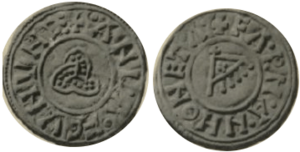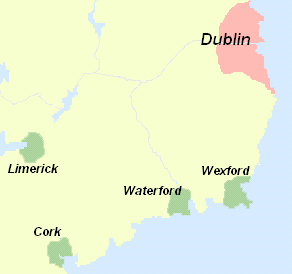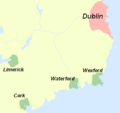Amlaíb Cuarán facts for kids
Quick facts for kids Olaf |
|
|---|---|

A coin minted at York in the early 940s, the obverse (left) face shows a triquetra and the legend ANLAF CVNVNCC (King Anlaf, the Old English form of Amlaíb /Óláfr), the reverse (right) face shows a banner, perhaps the Raven banner and the name of the moneyer, as FARMAN MONETA[rius]
|
|
| King of Jórvík | |
| Reign | 941 – 944 |
| Predecessor | Olaf Guthfrithson |
| Successor | Edmund I |
| Reign | 949 – 952 (second time) |
| Predecessor | Eric Bloodaxe |
| Successor | Eric Bloodaxe |
| King of Dublin | |
| Reign | 945 – 947 |
| Predecessor | Blácaire mac Gofrith |
| Successor | Blácaire mac Gofrith |
| Reign | 952 – 980 (second time) |
| Predecessor | Gofraid mac Sitriuc |
| Successor | Glúniairn |
| Died | 980 Iona, Scotland |
| Burial | Iona Abbey |
| Spouse | Dúnlaith Gormflaith |
| Issue | Glúniairn Sigtrygg Silkbeard Gytha Máel Muire Harald |
| Dynasty | Uí Ímair |
| Father | Sitric Cáech |
| Mother | Unknown |
Amlaíb mac Sitric (died 980), also known as Olaf Cuaran, was a powerful Norse-Gael leader in the 900s. He was a king in both Northumbria (part of England) and Dublin (Ireland). His special name, cuarán, means "sandal" or "shoe."
Olaf Cuaran was one of the last important members of the Uí Ímair family. This family played a big role in the history of the British Isles. Olaf ruled different areas for about 40 years. He was known as a strong warrior. He spent his final days in a monastery on Iona.
When Olaf was born, his family controlled large parts of Britain and Ireland. By the time he died, Dublin was a smaller kingdom. However, Dublin had become a very important trading city in Europe. Controlling Dublin and its wealth was a big prize for Irish kings.
Olaf Cuaran also inspired a character in an old English story called Havelok the Dane. He supported poets who wrote songs praising him. Olaf married at least twice and had many children. His children married into royal families in Ireland and Scandinavia. His descendants ruled the Isle of Man and the Hebrides until the 1200s.
Contents
Viking Age Beginnings
The first records of Vikings attacking Britain and Ireland appeared in the late 700s. For example, the monastery on Lindisfarne in Northumbria was attacked in 793. The monastery of Iona was attacked in 795 and 802. In Ireland, Rathlin Island was attacked in 795.
These raids continued for many years. In the early 800s, the raids became more frequent and larger. This is when the first permanent Viking settlements appeared. These settlements were called longphorts in Ireland.
Olaf's Family History
Olaf Cuaran belonged to the Uí Ímair family. This family was named after Ímar, who was called "king of the Northmen of all Britain and Ireland." He died in 873. Many historians believe this Ímar was Ivar the Boneless, a famous Viking leader.
Olaf Cuaran was likely a great-grandson of Ímar. His father, Sitriuc, took control of Dublin in 917. Dublin had been ruled by an Irish king since the Vikings were forced out in 902.
Sitriuc ruled Northumbria until he died in 927. He married the sister of King Æthelstan of England in 926. Some old stories say that Olaf was the son of Sitriuc and this English princess. Sitriuc had other sons, including Gofraid, who became king of Dublin.
After Sitriuc's death, Olaf might have been king in York for a short time. But King Æthelstan soon took over Northumbria. Olaf then fled to Ireland. In 937, Olaf's cousin, also named Amlaíb (Olaf), attacked Æthelstan's kingdom. This led to the battle of Brunanburh. Some stories say Olaf Cuaran was at this battle. He supposedly spied on the English camp disguised as a poet.
King Æthelstan died in 939. His half-brother, Edmund, became king. Edmund could not keep control of York. So, Olaf's cousin, Amlaíb mac Gofrith, became king of Northumbria. He died in 941.
Becoming King in York
Olaf Cuaran's time as king began in 941. He became co-ruler of York with his cousin Ragnall. Olaf had been in Britain since 940. He had left another cousin, Blácaire, in charge of Dublin.
Olaf and Ragnall ruled in York until 944. After King Æthelstan's death, King Edmund lost control of Northumbria. The Five Burghs (five important towns) in Mercia also pledged loyalty to Olaf's cousin. One of the Olafs attacked Tamworth. The Danes won and took many treasures.
King Edmund took back the Five Burghs in 942. The old records say that Olaf was baptized, and King Edmund became his godfather. This was often a political act. It did not necessarily mean Olaf was not already Christian.
Olaf was removed from the kingship of York in 944. The Anglo-Saxon Chronicle says that King Edmund "conquered all Northumbria and caused to flee away two kings, Olaf and Rægnald." It is possible that fighting between Olaf and Ragnall led to their downfall.
Battles and Alliances in Ireland
After being driven out of Northumbria, Olaf returned to Ireland. Dublin had been attacked in 944 by the High King of Ireland, Congalach Cnogba. The next year, Olaf's cousin Blácaire was removed, and Olaf became the ruler of Dublin. Olaf became an ally of Congalach.
Congalach and Olaf fought against Ruaidrí ua Canannáin, who also wanted to be High King. In 945, they defeated part of Ruaidrí's army. The next year, Olaf raided Kilcullen in Leinster. But in 947, Ruaidrí defeated Congalach and Olaf at Slane. Many Dublin men died trying to escape. This defeat meant Olaf lost his kingship. Blácaire became the leader of Dublin again. Blácaire was killed in 948, and Olaf's brother, Gofraid, took over Dublin.
Back to York (and Back to Ireland)

While Olaf was in Ireland, things in Northumbria were changing. King Edmund died in 946. His brother, Eadred, became king. Eadred took control of Northumbria. But then a Scandinavian king named Erik, likely Eric Bloodaxe, started ruling Northumbria. Eadred attacked the southern parts of Northumbria to make them expel Erik.
In 949, the people of Northumbria invited Olaf to rule in York again. His return might have been with King Eadred's agreement. That year, Máel Coluim mac Domnaill, the king of Scotland, raided Northumbria. It's not clear if this attack was against Olaf or to help him. In 952, another invasion from the north happened. This time, Scots, Britons, and Saxons were involved. They were defeated.
Olaf was removed from power in 952 and Erik became king again. Erik's rule was short. The Viking kingdom of York officially became part of England when Erik died in 954. Olaf returned to Ireland and never ruled in York again.
Final Years and Legacy
In 951, while Olaf was in Britain, his brother Gofraid died in Dublin. Congalach, Olaf's former ally, became the undisputed High King. This made him a threat to Dublin. Congalach died in 956. The next High King was Domnall ua Néill, who was the brother of Olaf's new wife, Dúnflaith. This marriage connected Olaf to powerful Irish families.
In the early 960s, Olaf faced challenges from his cousins. He also led raids in Leinster. He attacked Kildare in 964 and 967. In 967, he killed Muiredach mac Faeláin, a leader from Kildare.
In 968, Domnall ua Néill attacked Leinster and laid siege to Dublin for two months. He did not capture the city, but he took many cattle. Olaf, allied with the king of Leinster, attacked the abbey of Kells in 969.
In 970, Domnall ua Néill attacked Olaf's new ally, Domnall mac Congalaig. Domnall mac Congalaig was married to Olaf's daughter. Olaf and Domnall of Brega fought against Domnall ua Néill's army at Kilmona. Olaf's side won the battle. However, Domnall ua Néill eventually became the effective ruler of the midlands and Leinster.
In 977, two of Domnall ua Néill's sons were killed. The old records give Olaf credit for their deaths. Domnall ua Néill did not seek revenge. He retired to a monastery and died in 980.
After High King Domnall ua Néill died, Olaf's stepson, Máel Sechnaill mac Domnaill, claimed the title. In 980, Máel Sechnaill fought against Olaf's sons near the hill of Tara. Olaf himself was an old man by then. Warriors from the Isle of Man also fought alongside Olaf's sons. Olaf's son Ragnall died in the battle. Máel Sechnaill won a big victory and took control of Dublin. He made the people pay a heavy tribute.
After this defeat, Olaf gave up his power. His son Glúniairn (meaning "Iron Knee") took over. Glúniairn was also Máel Sechnaill's half-brother. Olaf retired to the monastery on Iona and died soon after.
His Family Life
Olaf was succeeded by his son Glúniairn. Glúniairn's mother was Dúnlaith. One of Olaf's wives was Gormflaith. She was the daughter of the King of Leinster and later married Brian Boru, another famous Irish king. Gormflaith's son, Sigtrygg Silkbeard, became king of Dublin after Glúniairn died.
Olaf also had other children:
- Gytha, who married Olaf Tryggvason, a Norwegian king.
- Máel Muire, who married Máel Sechnaill mac Domnaill.
- Harald, who might have been the grandfather of Godred Crovan.
What Does 'Cuarán' Mean?
Olaf's special name, cuarán, is usually translated as "sandal" or "shoe." It comes from an old Irish word meaning "bent" or "crooked." This name was first used for him in 947.
The translation "sandal" might be a bit misleading. The name probably referred to a special kind of footwear. One description from the 1100s says a cuarán was made of leather folded seven times and had a pointed toe. In some old stories, a cuarán was waterproof. It could even be used as a cup to drink from! It seems the cuarán was a type of shoe specific to Dublin.
Olaf in Old Stories
Olaf Cuaran (Olaf Kvaran) is mentioned in old Icelandic stories called sagas. He appears in Njal's Saga and Saga of Gunnlaugr Serpent-Tongue. These mentions show how famous he was in the Viking world.
See Also
Images for kids
-
A coin minted at York in the early 940s, the obverse (left) face shows a triquetra and the legend ANLAF CVNVNCC (King Anlaf, the Old English form of Amlaíb /Óláfr), the reverse (right) face shows a banner, perhaps the Raven banner and the name of the moneyer, as FARMAN MONETA[rius]
-
A second style of penny from York from Amlaíb's time, moneyer Æthelfrith, the obverse shows a bird, presumed to be a Raven, the reverse a cross.





